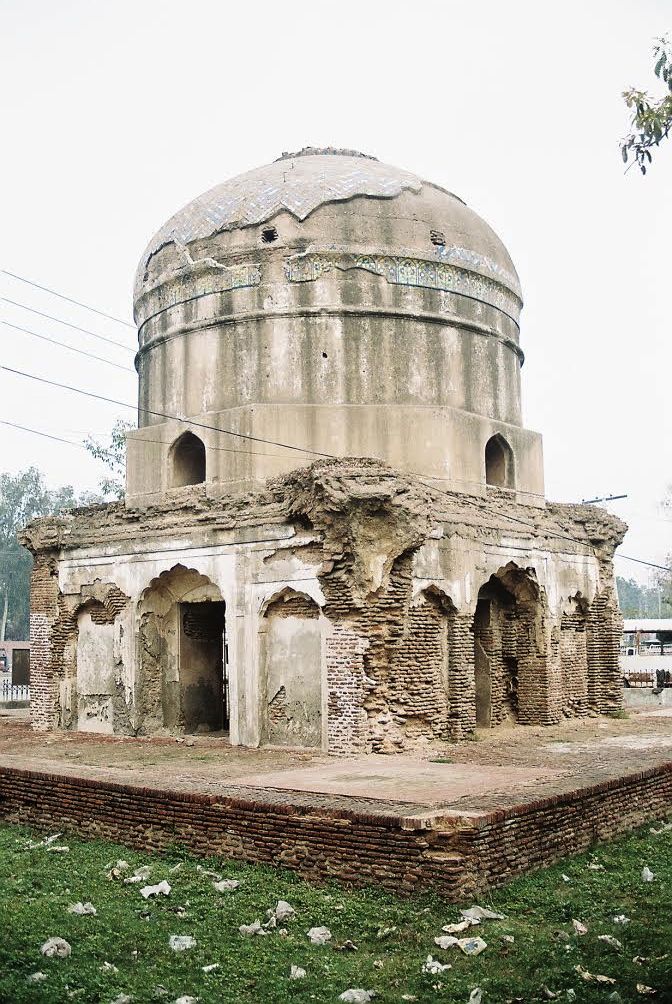
Mudassar Bashir
Translated and Edited: Muttahir Ahmed Khan
Whenever the rich history, culture and architecture of Lahore is discussed, one cannot ignore Budhu’s tomb which possesses a grand status amongst the city’s monuments.
Biography:
Budhu is widely known for not only his tomb but also his famous ‘Aava’. Aava is a term used in Hindi, Punjabi and Persian to refer to a kiln where the potters bake earthen pottery and bricks. The historical writings suggest that Budhu was buried at the place where he died. It is well established through historical records that he died at his Aava.
During the rule of Emperor Akbar, Lahore possessed a special status, due to being the hub of the state affairs, and remained the capital of the Mughal Empire in the last phase of Akbar’s rule. This factor made many nobles and the rich establish their houses in the city to remain closer to the court, and ultimately, several new areas and colonies were founded in the town. With the construction of new, luxurious and rich mansions, the brick makers made a large fortune.
A potter named Sidhu was very famous for making baked bricks during Jahangir’s reign. After Sidhu’s death, the whole business got into the hands of his son Budhu. Therefore, Budhu grabbed the contracts of bulk supply of bricks for the construction of the Shalamar Garden and Nister Khan’s tomb. The reason for this huge demand of bricks was the grand ramparts that were built around these premises. Nowadays, these walls can be occasionally seen.
With these orders pouring in, Budhu’s contacts in the court grew and eventually, he came to be a part of the nobility. Then suddenly, an event took place which totally changed his life.
One day, during a heavy rain, a old dervish Abdul Haq came to his kiln and asked for fire to warm himself in the cold weather. But, Budhu and his workers humiliated him and threw him out of the kiln. Due to this humiliation of the saint, the kiln did not light up in the succeeding days and the bricks remained raw and unfinished. After this setback, Budhu became unwell. Then, one night, he received an indication in his dream that the whole infliction upon him was the result of the humiliation and mistreatment of the dervish. The very next day, Budhu went to see the dervish, begged his forgiveness and became his devotee for good. After the demise of dervish Abdul Haq, Budhu himself laid the foundations of his tomb. Some historians opine that Budhu, after death, was buried beside the saint while some are of the view that he was laid to rest at the place where his Aava existed. Presently, the official gravestone at the tomb reads that Budhu is buried there.
The Tomb Premises
As we have already discussed, Budhu’s tomb was constructed at the site of his Aava. Maulvi Noor Ahmed Chishti writes in his book titled ‘Tahqiqat e Chishti’
“This Aava (kiln) is located at the distance of three miles to the eastern side of the city and is famous because of a potter called Budhu who lived during Shah Jahan’s period and his father named Sidhu was known in the era of Jahangir.”
During the British period, many beautiful and historical buildings were sacrificed to meet the needs of the railways and the associated departments. This destructive spree was started by the state and, later on, worsened by the citizens’ insensitive attitude. All included, Budhu’s Aawa, his tomb, the surrounding garden and all the beautiful buildings and boundary walls, was plundered and ruined. In the South, a graveyard was laid out and some houses were constructed to the North and East. To the West, some old houses still exist and are now being demolished to construct new shops. The mosaic work in blue shade is seen on top of the single dome, the same work is also present at Dai Anga’s Tomb.
A small ground, filled with piles of garbage, also exists around the tomb’s platform that has bolted doors on all four sides. There are two graves, enclosed by doors and grills, under the dome, the walls of which have been affected by termites. Due to the smoke, produced by the drug-addicts who often sit there, one can find many black patches and spots in different places.
The Budhu’s tomb is on one side of the road while University of Engineering and Technology Lahore exists to the eastern side of the other end. Nothing has been done by the past governments to preserve this four-century old building. But, more responsibility lies on the shoulders of the post-partition governments. If the status-quo persists, there would be no trace left of the tomb and its dome, the only surviving monument of Budhu’s Aava.